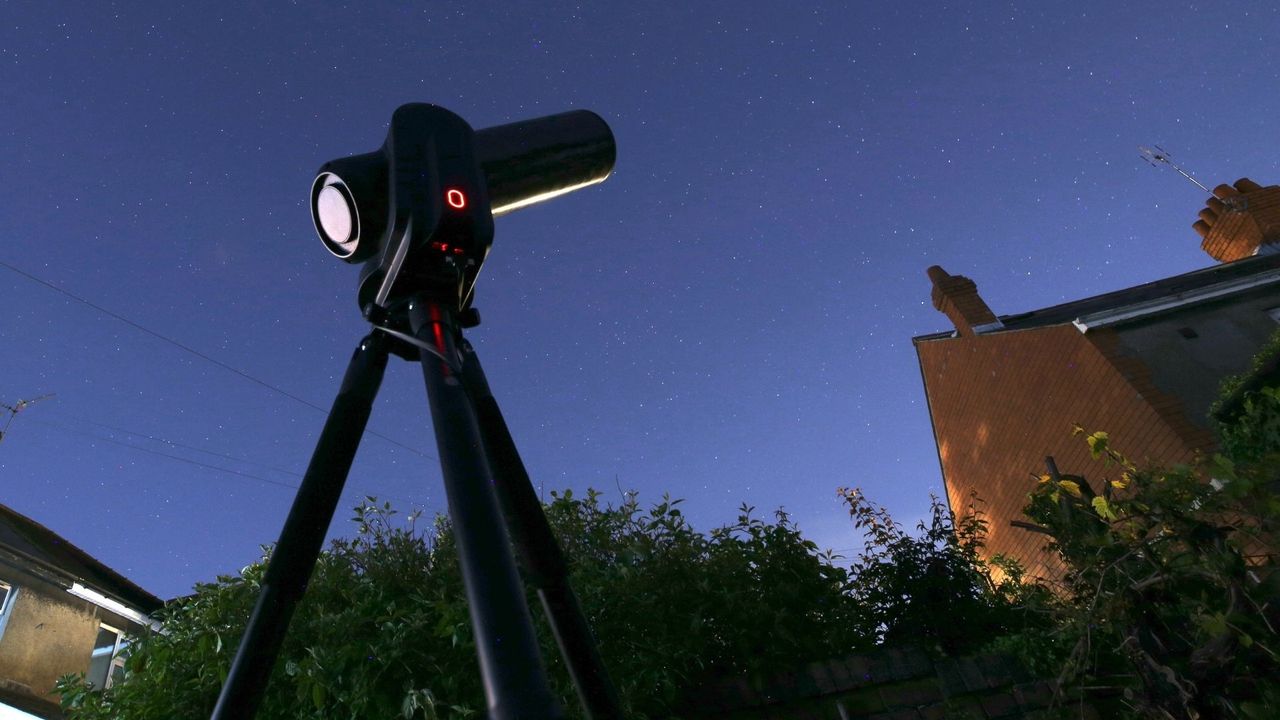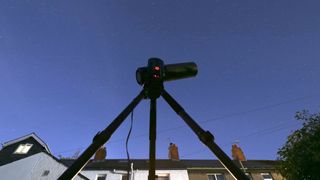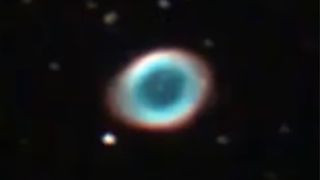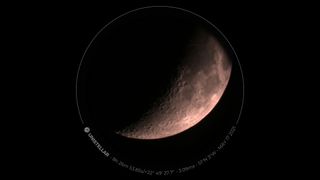Unistellar eVscope eQuinox smart telescope review
The Unistellar eVscope eQuinox smart telescope lets you marvel at heavenly bodies, even in light-polluted night skies. Here's our review

With advanced intelligent image processing and a jump in detail to 4.8 megapixels, the eVscope eQuinox smart telescope sacrifices an eyepiece for an app, but far out-performs similarly-sized small telescopes.
-
+
Incredible ‘enhanced vision’ views
-
+
Easy to share and observe in groups
-
+
Clear, colourful views under heavy light pollution
-
+
Very easy to set up and excellent build quality
-
-
Focusing takes a few minutes
-
-
App occasionally crashes
-
-
Field of view too narrow for the Moon
Why you can trust T3

Telescopes are for looking through, right? Not this one. A so-called ‘smart telescope’ that’s operated purely using an app, the Unistellar eVscope eQuinox is small but with a big ambition – to change amateur astronomy as we know it.
Launched in March 2021, the eVscope eQuinox isn't for looking through. Unlike most of the best telescopes, here the eyepiece is replaced by apps for smartphones and tablets that relay skilfully processed 'live' images to you. In fact, you can set up the eVscope eQuinox outside and simply sit inside inspecting its images (we've included a smart telescope in our best beginner telescope guide a result of this easier setup process).
It can do all this because at the heart of this small reflector telescope is a Sony IMX224 CMOS image sensor. The eVscope eQuinox takes photographs, but not just one per object. Select ‘enhanced vision’ after it’s pointed at an object and it takes image after image of the same object, with the intelligently processed stacked image on your device getting better with time. You can then save those images to your phone and share them on social media.
Read on for our full Unistellar eVscope eQuinox digital telescope review, or head to our Unistellar eVscope 2 review to find out more about the brand's latest flagship (which does come with an eyepiece).
- How to choose your first telescope
- Discover the different types of telescope, from refractor to Dobsonian
UNISTELLAR EVSCOPE EQUINOX: FIRST IMPRESSIONS
The eVscope eQuinox isn’t identical to its predecessor, the eVscope. Though it looks the same at first glance, its tube is a dark grey rather than light grey and, of course, there’s no eyepiece. Whether or not you see that as a positive or a negative, it has consequences, largely by allowing the telescope to have a much longer battery life. Whereas the original telescope worked for 10 hours, the eVscope eQuinox works for 12 hours.

Perhaps more crucially it’s got a lot more storage space than the original eVscope, with a healthy 64GB versus 12GB. Why is not immediately clear since the resolution of the images it produces hasn’t changed, remaining at 1.27 megapixels. However, during our review a firmware update upped that to an impressive 4.8 megapixels thanks to some advances in its image-stacking algorithms. Backyard astrophotography is on!
UNISTELLAR EVSCOPE EQUINOX REVIEW: SPECS
- Optical design: Reflector
- Objective lens diameter: 4.5”/114mm
- Focal length: 17.7”/450mm
- Focal ratio: f/4
- Software supplied: Unistellar app
- Optical tube length: 65cm
- Mount: Motorised alt-az
- Tripod: Aluminium construction, adjustable
- Weight: 19.8 lbs / 9kg including tripod
- Storage capacity: 64 GB
- Battery life: 12 hours
- Connectivity: WiFi (10 devices can connect at once)
- Maximum magnitude: up to 18 in dark skies/under 16 in urban areas
- Level: Beginner
UNISTELLAR EVSCOPE EQUINOX: PRICE AND RELEASE DATE
The eVscope eQuinox hails from Marseille, France and costs EUR €2,799 / GBP £2,599 / USD $2,699 (originally $2,999). Originally, Unistellar was charging for shipping ($/£/€59), which feels stingy on such a pricey product, but last time we checked, there was free delivery in all the main territories. The standard package does not include a backpack, but there is one available from Unistellar for €359 / £329 / US$429.
UNISTELLAR EVSCOPE EQUINOX: DESIGN AND SETUP
The eVscope eQuinox is very easy to set-up and the build quality is excellent – as you would expect at this high price. The first task is to unfurl its solid two-stage tripod, make sure it’s level using its built-in spitting level, then carefully place the tube onto it, tightening two screws to lock it in place.

As for aligning it with the stars, Unistellar’s Autonomous Field Detection technology takes care of that by imaging whatever stars it’s pointed at and cross-referencing them with its built-in planetarium software. It’s incredibly accurate. The only time it’s likely to fail is if you accidentally point it at clouds, try it too early in the evening before it’s properly dark, or point it close to a near-full Moon.
Its lack of eyepiece makes it slightly more difficult to focus, but we had no problems using an included Bahtinov mask. All you have to do is place this plastic disk on the end of the telescope, slew it to a bright star, then twiddle the focusing knob until you get three spikes of light to intersect.
UNISTELLAR EVSCOPE EQUINOX REVIEW: FEATURES AND USABILITY
One of the joys of using a telescope outdoors is to share the night sky with others, so the eVscope eQuinox allows up to 10 observers to download the Unistellar app on smartphones or tablets and get the image fullscreen. It’s possible to pinch-to-zoom, too.
The Unistellar app has a catalogue of 5,400 objects, which it aligns to using your phone’s GPS in conjunction with its built-in compass and accelerometer. You tell it where you’re observing it from – an urban or rural location – and it will customise its suggested targets of what it thinks you’ll get good views of. Although the app teaches you exactly what most of those objects are, there are significant gaps.

It’s not obvious how long you must point the eVscope eQuinox at any given object to get the best image; sometimes you may already have the best possible image after 10 seconds while other times you can wait 10 minutes before the image really starts to become impressive. So some patience is required.
In our tests the eVscope eQuinox ran for a marathon six-hour observing session no problem, though we did have a portable battery (of the kind you might use for your smartphone) nearby just in case. It hooks-up via USB-C, while a USB-A slot lets you recharge your phone from its built-in battery.
There’s also a ‘citizen scientist’ community dimension to this telescope, with Unistellar setting-up occasional virtual star parties where users can manually punch-in coordinates of, say, a comet that’s just appeared, or an asteroid that’s occulting a star.
UNISTELLAR EVSCOPE EQUINOX REVIEW: IMAGES
Doesn’t the eVscope eQuinox just download images from the internet and show them to you on your smartphone or tablet, thus easily fooling you into parting with your cash for no reason? No, it does not! We know this because, firstly, a satellite went right across a few of the objects we pointed the eVscope eQuinox at. And it also becomes obvious fairly quickly that while some objects – such as the Ring Nebula (M57), the M81 spiral galaxy and M5 globular cluster – look great at first glance and, as the ‘enhanced vision’ mode keeps snapping away, just get clearer and more colourful, some galaxies and nebulae (such as a the delicate Bubble Nebula) don’t look great.

There are lots of variables at play here, from sky clarity to local light pollution, but the eVscope eQuinox shows you much more detail, brightness and colour than any other small telescope you can buy to use in your backyard. Unfortunately, it’s 20 times more expensive than most decent backyard telescopes. Is it 20 times better? Well, yes, in terms of what it can show you, yes it is.
UNISTELLAR EVSCOPE EQUINOX REVIEW: VERDICT

Now to the crux of our Unistellar eVscope eQuinox telescope review: should you actually buy one? It depends, really, on what you're after. Not having a live view through an eyepiece does feel odd for anyone who is used to using a small backyard telescope. While most small telescopes with similar optical specifications to this one really only offer decent views of planets and the Moon, the eVscope eQuinox concentrates solely on deep sky objects. So in many ways it's a complement to a small backyard telescope, not an upmarket replacement.
Is it an astrophotography telescope? Technically, yes, and all the images it produces are increasing in resolution, but the eVscope eQuinox will be most adored by anyone frustrated with how little of the deep sky they can see from a light-polluted back garden.
First reviewed in May 2021.
Sign up to the T3 newsletter for smarter living straight to your inbox
Get all the latest news, reviews, deals and buying guides on gorgeous tech, home and active products from the T3 experts
Jamie is a freelance journalist, copywriter and author with 20 years' experience. He's written journalism for over 50 publications and websites and, when he's not writing, spending most of his time travelling – putting the latest travel tech through its paces.
-
 DJI just made off-grid power easier than ever
DJI just made off-grid power easier than everDrone giant’s new charging solutions can power your adventures at super-fast speeds
By Matt Kollat Published
-
 Netflix gives a glimpse into new thriller starring a titanic Oscar-winner
Netflix gives a glimpse into new thriller starring a titanic Oscar-winnerZero Day is going to start with a bang
By Max Freeman-Mills Published
-
 I saw the future of Samsung Galaxy phones – but now have more questions than answers
I saw the future of Samsung Galaxy phones – but now have more questions than answersThe Samsung Galaxy S25 Edge is real
By Mike Lowe Published